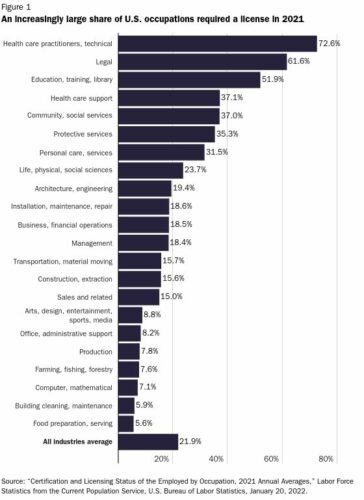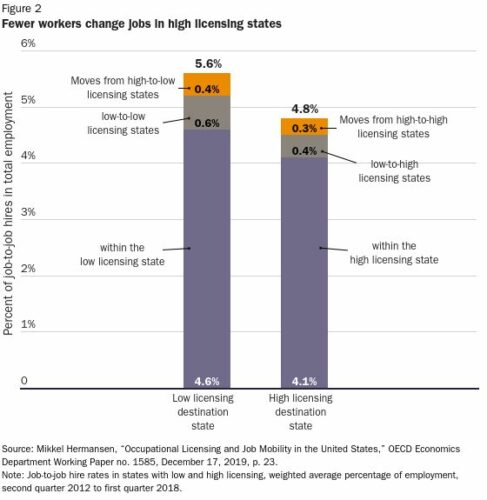
11.10.22 – CATO Institute
The Issue
The dramatic increase in occupational licensing restrictions needlessly discourages work and mobility
The United States’ relatively free and flexible labor markets support worker opportunities and boost lifetime earnings and economic growth.1 However, one type of regulatory barrier, occupational licensing, has increased over the last several decades to affect more than one‐fifth of the workforce, raising costs and undermining worker choices in the process.
State governments bar individuals from entering many occupations unless they fulfill specific educational, training, and testing requirements. Occupational licensing requirements vary by state, but they typically cover dozens of professions ranging from doctors and lawyers to cosmetologists, manicurists, barbers, preschool teachers, athletic trainers, makeup artists, security alarm installers, taxidermists, sports coaches, travel agents, bartenders, animal trainers, tree trimmers, tour guides, interior designers, auctioneers, massage therapists, and many others.2
The share of U.S. jobs requiring an occupational license increased from 5 percent in the 1950s to 22 percent in 2021.3 Other estimates put today’s share even higher.4 Figure 1 shows the share of workers with a license by industry. The number of occupations requiring a license in at least one state rose from about 30 in 1920 to about 1,100 today.5 The share of workers needing licenses ranges from 14 percent in Georgia to 27 percent in Nevada.6

The increase in mandatory licensing has reduced workforce mobility and created barriers to work and advancement. The barriers particularly harm young people starting their careers, people with low incomes, people switching occupations, people moving between states, veterans or military spouses, and people with a criminal record.
Morris M. Kleiner (2015), for example, estimated that “the restrictions from occupational licensing can result in up to 2.85 million fewer jobs nationwide, with an annual cost to consumers of $203 billion.”7 Similarly, a 2018 Federal Trade Commission report found that while occupational licensing supports health and safety in some cases, it also reduces labor supply, restrains competition, and raises prices.8 Kleiner and Evan J. Soltas (2019) examined license variation among the states and found that shifting an occupation from unlicensed to licensed reduces employment in the licensed occupation by 29 percent.9 The economists also discovered that licensing requirements delay the entry of younger workers into the relevant occupations far beyond the amount of time needed to meet any relevant education requirements. Kleiner and Ming Xu (2020) found that licensing has significant negative effects on occupational mobility when switching both in to and out of licensed occupations, accounting for “at least 7.7 percent of the total decline in occupational mobility over the past two decades.”10 Such barriers also discourage hiring across state lines, and thus limit workers’ interstate mobility.11 As Figure 2 shows, states with licensing requirements for more occupations (i.e., high licensing states) experience fewer job‐to‐job (i.e., directly from another employer) hires than do states with fewer licensing burdens.

Recent federal administrations have rightly been critical of licensing. A 2015 report by Obama administration economists concluded, “There is evidence licensing requirements raise the price of goods and services, restrict employment opportunities, and make it more difficult for workers to take their skills across state lines.”12 The Trump administration also prioritized licensing reform, and its Federal Trade Commission continued several Obama‐era actions targeting onerous state licensing regimes.13 And the Biden’s administration’s Economic Report of the President for 2022 found that “occupational licensing can make it more difficult for workers to enter fields or move to places where their human capital would be more productive by increasing the cost of mobility in terms of fees for obtaining a license or time to complete required training or other licensing requirements.”14
Many licensed occupations are found in small businesses, so licensing restrictions are restrictions on entrepreneurship, particularly for disadvantaged individuals. Stephen Slivinski (2015) found that those states that require licenses for a larger number of occupations with typically moderate incomes have lower rates of low‐income entrepreneurship.15 The Institute for Justice (IJ) calculated in 2017 that lower‐income occupational licenses require, on average, nearly a year of education or experience, one exam, and more than $260 in fees.16 Such burdens are disproportionately heavy for individuals who are unemployed, living paycheck‐to‐paycheck, or raising a child alone.
Military spouses are also disproportionately affected by state licensing rules, given the type of work they often do and their families’ frequent interstate travel.17 Also, veterans with specialized military training often find themselves ineligible for a license to do the same work as a civilian.18 And, as discussed in the criminal justice chapter, licensing rules often bar individuals with a criminal record from applying, thus thwarting worthwhile “prison entrepreneurship” programs intended to rehabilitate inmates and decrease recidivism.19 Only a few states earn good grades in this regard, despite the entrepreneurship programs’ efficacy. States with heavier occupational licensing burdens have been found to have higher recidivism rates than those with lower barriers to entry, while states with the fewest barriers actually saw recidivism rates decline.20
Just as importantly, the usual consumer protection rationales for licensing have proven to be weak. Kleiner (2015) reviewed the academic literature and found that there “is little evidence to show that the licensing of many different occupations has improved the quality of services received by consumers.”21 Similarly, the 2015 Obama administration report concluded that “most research does not find that licensing improves quality or public health and safety.”22 More recent research shows much the same: Peter Q. Blair and Mischa Fisher (2022), for example, reviewed 21 million online transactions in the $500 billion home services market and found that “licensing a task reduces service provider surplus and platform surplus without increasing consumer surplus”—thus confirming previous studies of licensing’s lack of benefits for consumers on digital platforms.23 And looking internationally, a report by the Organisation for Economic Co‐operation and Development found that “there is very little empirical evidence of a positive link between the stringency of regulations and the quality of services.”24
That there are large differences in state licensing requirements and covered occupations is a strong indication that many licenses are unnecessary or overly burdensome. Athletic trainers, for example, are not licensed in California, but in Nevada they must have a college degree, pass an exam, and pay $666 for an initial license and $150 for annual renewals.25 Auctioneers are not licensed in about half the states, but in North Carolina they must have a college degree, pass an exam, and pay $450 for an initial license and $250 for annual renewals. Heating, ventilation, and air conditioning (HVAC) contractors are not licensed in more than a dozen states, but in Nevada they must pass an exam and pay $1,135 for an initial license and $600 for biennial renewals.
Such large interstate differences suggest that rules are not based on analyses of health or safety but rather reflect differences in state and local politics. Current members of professions often sit on state regulatory boards, and they tend to favor increasing licensing requirements to limit entry and reduce competition. They also often lobby for new restrictions and against reform of current ones. For example, a 2022 IJ study shows that occupational licensing is usually initiated by industry groups, not consumers.26 Numerous states use “sunrise reviews” when considering imposing new occupational licenses. The Institute for Justice studied 494 such reviews in 15 states from 1985 to 2017 and found that industry groups initiated 83 percent of the reviews, generally in the hopes of prompting lawmakers to impose licensing. For example, the “Maine Association of Wetland Scientists sought licensure of soil scientists and the Vermont Alarm and Signal Association sought licensure of burglar alarm installers.”27
Sunrise reviews are a good idea when they are performed by independent experts, as they inform policymakers about the downsides of licensing. Just 20 percent of the independent reviews that IJ examined recommended adding new licensing rules.28 Thus, the good news is that experts usually find that the costs of licensing are higher than the benefits.
The bad news, however, is that state legislatures often ignore the experts, as new licensing rules were enacted after 41 percent of the sunrise reviews. For example, lactation consultants often get voluntarily certified to signal their professional skills, but Georgia legislators mandated licensing in 2016, even though a state sunrise review recommended against it. The law required about two years of college courses and more than 300 hours of supervised clinical work. It threatened to put hundreds of current lactation consultants out of work and make them pay to get recertified, even though many had years of experience and voluntary certification. The Georgia law is currently on hold due to litigation.
Other examples of new licensing, even after state reviews recommended against, include: athletic trainers in Florida, Hawaii, and Washington; hearing aid dispensers in Colorado; HVAC technicians in South Carolina and West Virginia; landscape architects in Colorado, Vermont, and Virginia; massage therapists in Colorado, Georgia, and Virginia; motor vehicle salespeople in West Virginia; nutritionists in Hawaii; plumbers in South Carolina and West Virginia; tattooists in Minnesota and Virginia; and timekeepers in mixed martial arts in Hawaii.29 Unfortunately, licensing is often “driven by special interests, not the public interest,” concluded the 2022 IJ study.30
The Policy Solutions
Repeal unnecessary licenses; embrace interstate license recognition; reduce licensing burdens for highly mobile or disadvantaged groups; and lower licensing fees
In response to growing evidence of licensing’s downsides, labor experts across the political spectrum have called for reforms to liberalize occupational licensing rules, and many states are pursuing such proposals. The best reform option for many occupations is full repeal of the state licensing requirement, particularly when licensing is unrelated to health and safety or is unnecessary. A simple way to determine if a licensing requirement is needed is to examine the experience of other states. States should lean toward repealing licensing of an occupation when numerous other states do not require it. In 2020, for example, Florida repealed licensing for interior designers, nail technicians, hair braiders, and boxing announcers.31 Florida knew that repealing licensing for interior designers made sense because most states do not license that occupation.
Another reform approach is for states to perform cost‐benefit analyses on all current licensing requirements and to repeal those that do not generate overall net benefits. Such analyses can be part of periodic “sunset reviews” performed by independent examiners on a rotating basis. For example, Utah recently added a requirement for a detailed examination of existing license requirements every 10 years.32
A further reform option is to replace compulsory licensing with voluntary (and superior) market mechanisms. For example, many occupations, such as those in information technology, eschew licensing and instead rely on workers gaining qualifications through voluntary certification. Such certifications encourage skill accumulation and signal worker abilities, but they do not pose a hard, artificial barrier to employment since they are voluntary. They also apply universally and thus do not restrict workers’ interstate mobility.
Short of repealing licensing requirements, state policymakers should support worker mobility by opening their workforces to individuals licensed in other states.33 If a person is licensed as, say, a nurse in one state, that individual should not face the costs of retaking courses and tests after moving. As discussed in the health care chapter, the need for greater interstate mobility was evident during the pandemic, as states facing surging hospital demands needed temporary help from doctors and nurses licensed elsewhere (and thus those states temporarily waived various licensing requirements).
One way to improve interstate mobility is through “compacts” among states, which recognize members’ licenses for particular occupations. The Nurse Licensure Compact, for example, allows nurses in more than 30 states to practice in other states that are compact members.34 Other multistate compacts exist for physical therapists, psychologists, and emergency medical services personnel.35 A broader and likely better approach to interstate licensing reform is universal recognition, which was first passed by Arizona in 2019.36 Governor Doug Ducey (R‑AZ) championed the reforms, noting, “Plumbers, barbers, nurses, you don’t lose your skills simply because you pack up a U‑Haul truck and move to Arizona.”37 The law allows for expedited licensing approval for Arizona residents who hold similar licenses from other states. After the Arizona reform, 17 other states have enacted similar reforms, thus allowing greater interstate worker mobility.38
Other reforms can reduce the harms of licensing, especially for disadvantaged groups. One popular reform in recent years has been for states to direct licensing boards to grant a license to a veteran with equivalent military training, education, and experience. Other states have waived civilian training requirements and allow veterans to sit for licensure exams based on military training and experience alone. However, not all states have adopted these reforms; reformer states have omitted certain professions; and the reformed process can remain costly and time‐consuming.39
States have also loosened licensing rules for military spouses, who often move frequently during their careers. About “35 percent of military spouses are employed in professions that demand a license, and those same families are 10 times more likely to move across state lines within the previous year than their civilian counterparts.”40 Reforms for military spouses are a good step, but spouses of other mobile professionals face similar problems and deserve relief as well.
Policymakers should also rethink licensing prohibitions related to past criminal activity. In about half the states, “applicants can be denied a license due to any kind of criminal conviction, regardless of whether it is relevant to the license sought or how long ago it occurred.”41 As detailed in the criminal justice chapter, individuals with criminal records are more likely to be unemployed or under‐employed. It is in everyone’s interest that they reboot their lives in a productive manner: finding employment is “a critical aspect of reducing recidivism” for ex‐convicts, and licensing liberalization can support that goal.42
As discussed in the health care chapter, states also should liberalize scope‐of‐practice rules to narrow the services that only licensed professionals are allowed to provide. For example, expanding scope‐of‐practice rules for nurse practitioners or dental hygienists to perform some services currently performed by doctors or dentists, respectively, could reduce costs in the health care system and lower prices for consumers. Finally, if repeal and other reforms are not politically possible for certain occupations, states should at least cut the costs of obtaining and renewing licenses.
Action Plan
Licensing may be appropriate in some technical professions where there are substantial health and safety concerns, but for most occupations such restrictions are unnecessary and harmful for American workers and the economy more broadly. Most often, market mechanisms, such as voluntary certification, can address any consumer protection concerns.
Every American has the right to “life, liberty, and the pursuit of happiness.” Freedom to use one’s labor in a chosen occupation is central to that pursuit. As such, policymakers should reject attempts to impose new licensing rules, and they should reduce existing requirements to maximize worker freedom in the marketplace.
State governments should
- not impose any new occupational licensing rules but rather rely on market‐based mechanisms such as voluntary certification;
- review all current occupational licensing rules and repeal those that fail a cost‐benefit test or that most other states do not require;
- establish independent “sunset reviews” for all licenses;
- where licensing is appropriate, work to increase interstate acceptance of licenses and reduce the costs of compliance, preferably through universal recognition;
- liberalize licensing rules related to past convictions, where appropriate, to encourage ex‐convicts reentering the workforce;
- loosen licensing rules for veterans with equivalent military training, as well as for military spouses and other American workers who often move frequently during their careers; and
- liberalize scope‐of‐practice rules to narrow the services that only licensed professionals are allowed to provide.
Download the Publication
ABOUT THE AUTHOR

Chris Edwards
Kilts Family Chair in Fiscal Studies
